Table of Contents
- Overview of the Antminer L9
- Specifications & New Features
- What coins L9 can mine & How to calculate Return of Investment
- Prerequisites for Setup
- Hardware Requirements
- Software & Account Requirements
- Physical Installation
- Unboxing & Inspection
- Power the L9 Miner from the PDU
- Network Connection and Physical Positioning
- Accessing the Miner Interface
- Finding the IP Address
- Logging In & Security
- Mining Pool Configuration
- Choosing Kryptex as Scrypt Pool setup example
- Start Mining
- Conclusion
- Questions to be answered
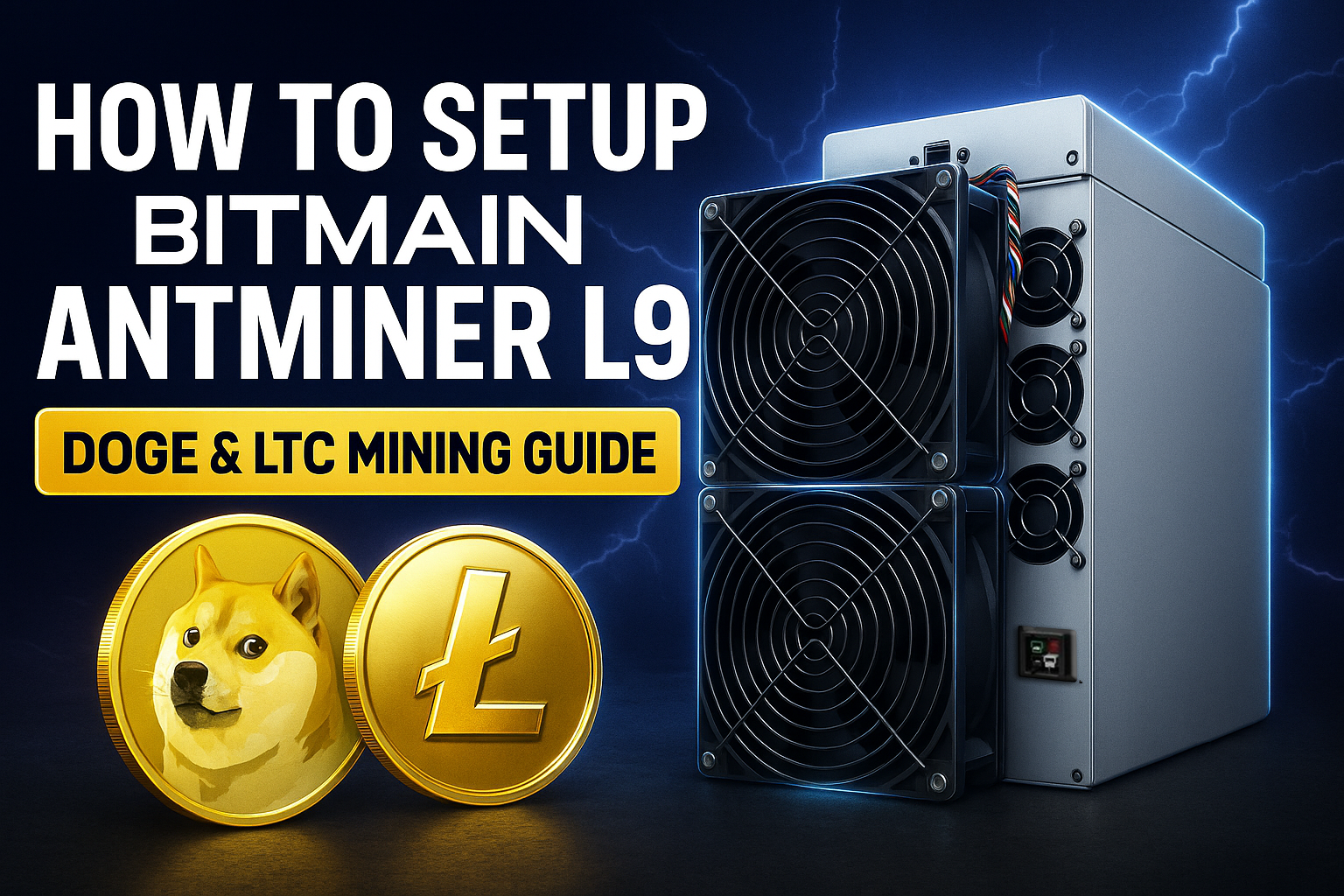
How to Setup Bitmain Antminer L9? Step-by-Step Guide for LTC & DOGE Mining
The Bitmain Antminer L9 represents a significant advancement in Scrypt algorithm mining technology, offering miners a powerful solution for Litecoin (LTC) and Dogecoin (DOGE) mining operations. With its remarkable up to 17 GH/s hashrate and enhanced energy efficiency compared to previous models, proper configuration is essential to maximize mining potential and return on investment. This comprehensive guide provides detailed, step-by-step instructions for setting up your Antminer L9, drawing from extensive hands-on experience and industry best practices.
Overview of the Antminer L9
Specifications & New Features
The Antminer L9 showcases Bitmain’s cutting-edge Scrypt mining technology with up to 17 GH/s while consuming approximately 3360W of power, resulting in an efficiency rating of 0.21 J/MH. This represents a 30% improvement in energy efficiency compared to previous Litecoin mining models like the L7, significantly enhancing long-term profitability.
Physically, the Antminer L9 measures 400 x 195 x 290mm and weighs approximately 13.2 kg, following Bitmain’s standardized chassis design for ease of installation in mining racks. The miner operates optimally in ambient temperatures between 5-45°C (41-113°F) and connects to networks via a standard Ethernet port. Miners should be prepared for its operational noise level of approximately 75dB, comparable to a household vacuum cleaner or busy traffic.
What coins L9 can mine & How to calculate Return of Investment
The Antminer L9 is primarily designed to mine Litecoin (LTC) and Dogecoin (DOGE), using the Scrypt algorithm. While it can also mine other Scrypt-based coins at the same time, like Bells(BEL), LuckyCoin(LKY),Pepecoin(PEP), Junkcoin(JKC), DINGO etc.
For Antminer L9 daily profit and ROI, you can check the calculate in this page
Prerequisites for Setup
Hardware Requirements
Before beginning the setup process, ensure you have all necessary hardware components to avoid delays and potential issues:
- C19 outlet PDU 220V:
- Electrical Infrastructure: Given the L9’s power consumption of approximately 3360W, verify your electrical infrastructure can support this load. According to electrical safety standards, a dedicated 20A circuit is recommended for each miner. Most mining operations require a 220-240V circuit. Professional mining facilities typically install PDUs (Power Distribution Units) rated for continuous high-load operation.
- Network Equipment: Ethernet Router or Switch
Software & Account Requirements
On the software side, you’ll need several tools and accounts to ensure smooth operation:
Computer Access: Access to a computer with a modern web browser (Chrome, Firefox, or Edge) to configure the miner. The configuration interface works best with updated browsers that support HTML5 and JavaScript.
IP Discovery Tools: Download Bitmain’s IP Reporter tool from their official support site to help locate your miner on the network. Alternative tools include Advanced IP Scanner or Angry IP Scanner for systems where the Bitmain tool isn’t compatible.
Mining Pool Accounts: Create accounts with mining pools that support Scrypt algorithm and merge mining. popular options include:
- ViaBTC: Offers PPS+ payment method with approximately 2.5% fees and merged mining for LTC and DOGE + BEL +LKY +JKC+Dingo. ViaBTC also provide Exchange for BEL +LKY +JKC+Dingo
- F2Pool: merged mining for LTC and DOGE + BEL +LKY +JKC+Dingo
Each pool has different minimum payout thresholds and fee structures, so research thoroughly before committing.
Wallet Addresses: Secure cryptocurrency wallets for receiving mining rewards. For BEL, LKY, JKC, Dingo, you may consider Using CoinEx for the wallet.
Physical Installation
Unboxing & Inspection
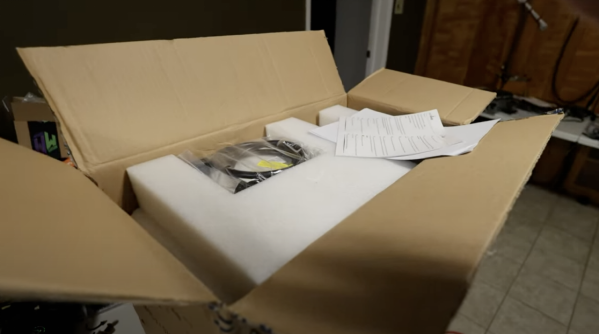
Upon receiving your Antminer L9, follow these detailed inspection steps to ensure your equipment is in perfect condition:

- No Damage on Miner Surface
- 15A P13 to C19 power cable x 1 , L9 Miner x 1 , User manual all there.
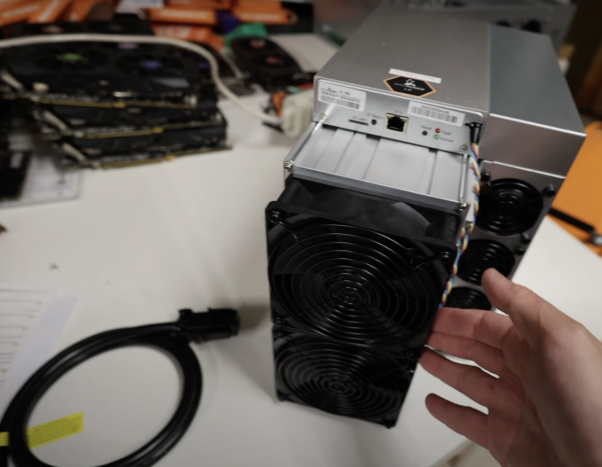
Power the L9 Miner from the PDU
Connect the power to the Antminer L9 from the 220V PDU
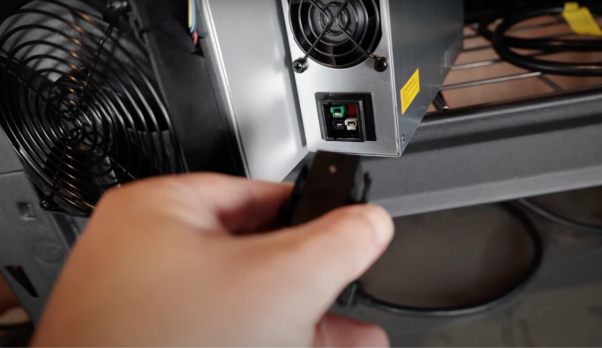
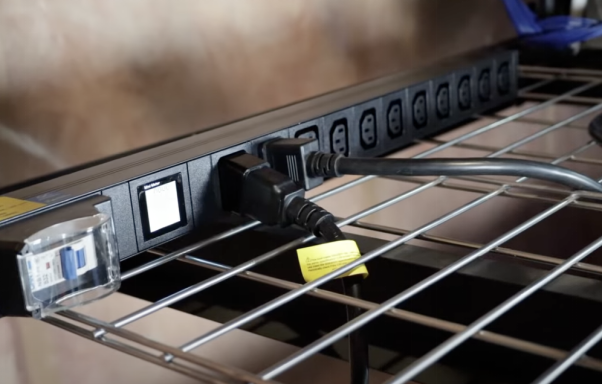
Network Connection and Physical Positioning
Accessing the Miner Interface
Finding the IP Address
To configure your Antminer L9, you first need to find its IP address on your network using one of these reliable methods:
Method 1: Using Bitmain’s IP Reporter Tool: Download the IP Reporter tool from Bitmain’s support website.
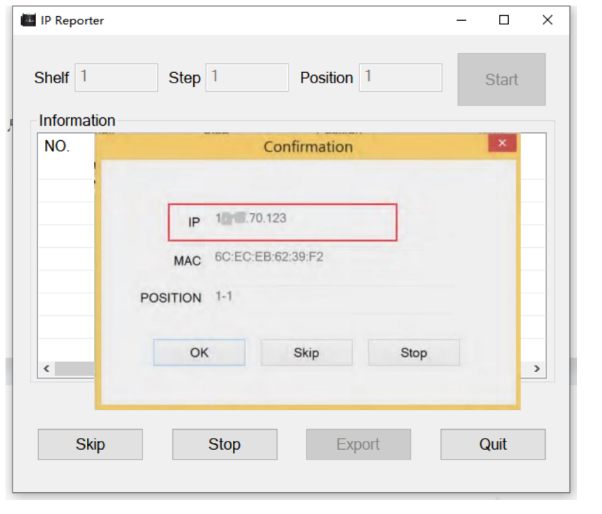
Once you have the IP address, enter it into your web browser’s address bar to access the miner’s web interface.

Logging In & Security
When you first access the Antminer’s web interface, you’ll need to log in and immediately implement security measures:
- Enter the default login credentials when prompted. For most Antminer L9 units, the default username is “root” and the password is “root” (some firmware versions may use “admin” for both).
- If your miner will be accessible from outside your local network, consider implementing two-factor authentication through a reverse proxy or VPN solution.
- Regularly check for firmware updates that address security vulnerabilities. Bitmain periodically releases security patches for their mining hardware.
Mining equipment has become an increasingly popular target for hackers, particularly as cryptocurrency values have increased. According to a 2023 report by CipherTrace, attacks specifically targeting mining equipment increased by 56% compared to the previous year, with many attackers repurposing compromised miners for their own mining operations or launching larger network attacks.
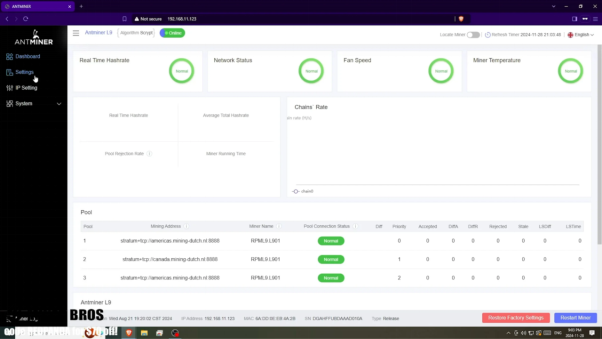
Mining Pool Configuration
Choosing Kryptex as Scrypt Pool setup example
- Now, go to the settings page. You will find the options to add the mining pool, worker’s name, and password.
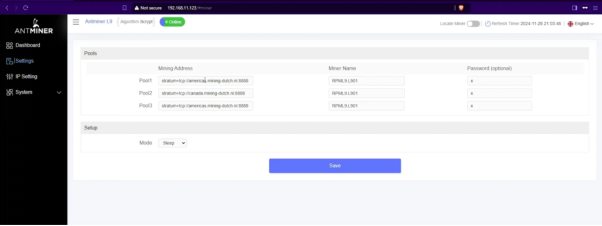
2. Here we use Kryptex pool for illustration.
3. You can find the Litecoin/Dogecoin option listed. Select it and click on the “Start Mining” button.
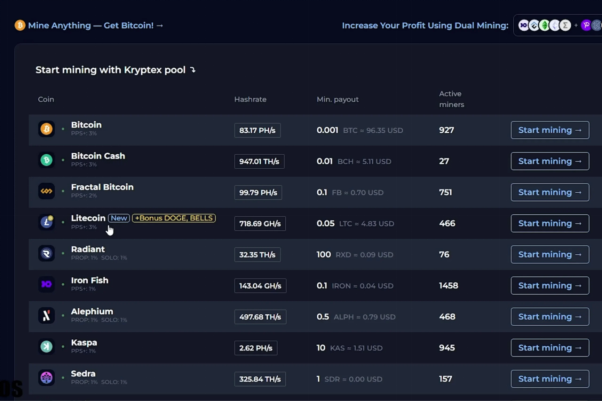
4. After clicking “Start Mining” button, you will find mining pool addresses. You can copy that address.
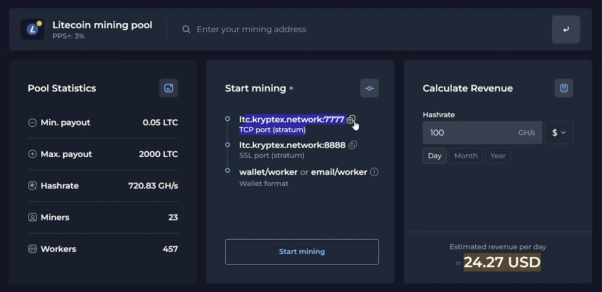
5. then return back to the miner settings page. Paste the copied mining pool address into the mining address field. Ensure you add stratum+tcp before the mining address.
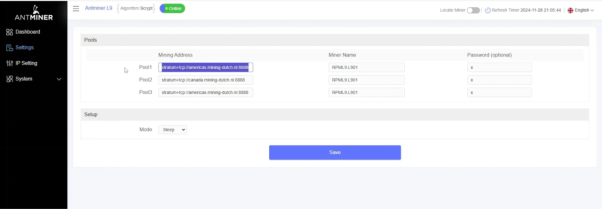
You can copy the backup pool addresses and paste them into pool2 and pool3. Thus, if one mining pool goes down, miner can switch to backup pool to continue mining.
6. Now, you can add your wallet address to your miner’s name. You can add your worker’s name to the wallet address, separated by a period. Here the worker’s name is L901, as you see below.

7. change the mode to “Normal.” and Click “Save” button
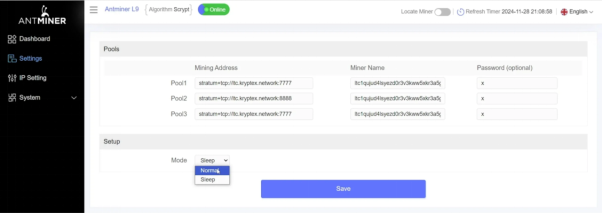
Start Mining
Miner will start hashing in few minute, and once it start hashing, you will able to see the status from the miner dashboard.
You may as open the mining pool dashboard to monitor the miner hashrate.

Conclusion
Bitmain Antminer L9, with upto 17Gh/s hashrate and 3260W power, is the most advanced LTC & Dogecoin miner in 2025. The 0.21J/Mh Energy efficiency and the Multicoin Merge mining can provide miners with the maximum long term profit in crypto mining.
Questions to be answered
- What to mine with Antminer L9?
– The L9 is optimized for Scrypt-based coins like Litecoin (LTC) and Dogecoin (DOGE). Use merge mining to mine LTC as primary and receive DOGE, BEL, LKY, JKC, DINGO rewards simultaneously, boosting profitability.
- Is Antminer L9 loud? Can L9 be able to run at home?
– Antminer L9 equipped with 4 high-speed cooling fan, which can generate 75db noise. Therefore, the noise can be issue for running L9 at home. But there are some third party miner silencer people may get from the market. However, this is at your own risk. Also Antminer L9 Requires 220V power. There are many people running L9 from their basement. However, as a professional miner, The best place to run antminer L9 is dedicated mining room.
- How much can an Antminer L9 make a month? – Earnings depend on LTC/DOGE prices, network difficulty, your electricity cost ($/kWh), pool fees, and the L9’s hashrate (16 Gh/s). Use calculators to estimate daily/monthly revenue before fees.



